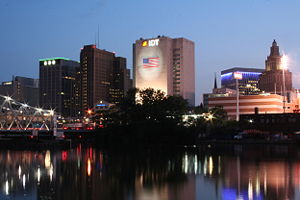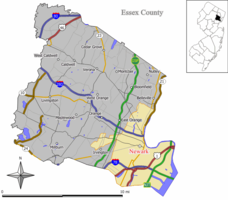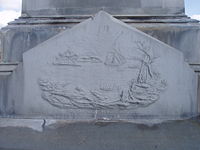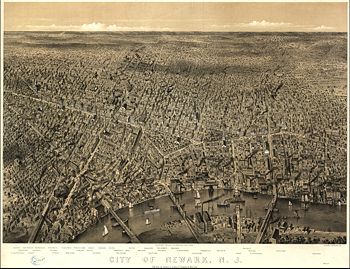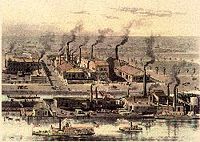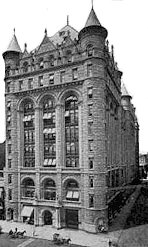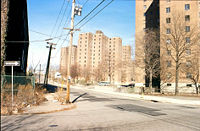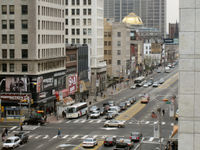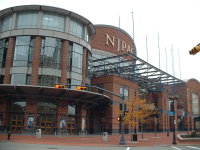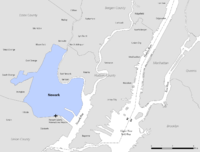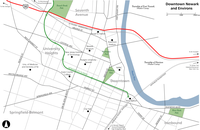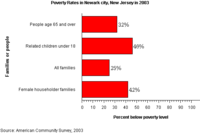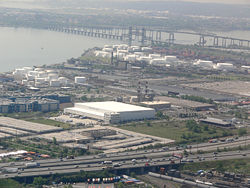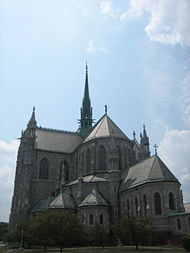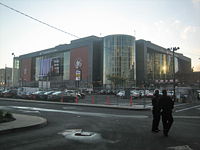Newark, New Jersey
2008/9 Schools Wikipedia Selection. Related subjects: Cities; North America
| City of Newark | |||
|
|||
| Nickname: The Brick City | |||
| Map of Newark in Essex County | |||
| Coordinates: | |||
|---|---|---|---|
| Country | United States | ||
| State | New Jersey | ||
| County | Essex | ||
| Founded/Incorporated | 1666/1836 | ||
| Government | |||
| - Type | Faulkner Act (Mayor-Council) | ||
| - Mayor | Cory Booker, term of office 2006–2010 | ||
| Area | |||
| - City | 26.0 sq mi (67.3 km²) | ||
| - Land | 23.8 sq mi (61.6 km²) | ||
| - Water | 2.2 sq mi (5.7 km²) | ||
| Elevation | 30 ft (9 m) | ||
| Population (2006) | |||
| - City | 281,402 | ||
| - Density | 11,400/sq mi (4,400/km²) | ||
| - Metro | 18,818,536 | ||
| Time zone | Eastern Standard Time ( UTC-5) | ||
| - Summer ( DST) | EDT ( UTC-4) | ||
| ZIP codes | 07100-07199 | ||
| Area code(s) | 862, 973 | ||
| FIPS code | 34-51000 | ||
| GNIS feature ID | 0878762 | ||
| Website: http://www.ci.newark.nj.us/ | |||
Newark is the largest city in New Jersey, United States, and the county seat of Essex County. As of the 2000 Census, the city had a total population of 273,546, making it the largest municipality in New Jersey and the 64th largest city in the U.S. According to the US Census Bureau, the city's 2006 population estimate is 281,402, an increase of 2.9% from 2000.
It is located approximately five miles (8 km) west of Manhattan and two miles (3 km) north of Staten Island. Its location near the Atlantic Ocean on Newark Bay has helped make its port facility, Port Newark, the major container shipping port on Newark Bay and for New York Harbour. Together with Elizabeth, it is the home of Newark Liberty International Airport, which was the first major airport to serve the New York metropolitan area.
Newark was originally formed as a township on October 31, 1693, based on the Newark Tract, which was first purchased on July 11, 1667. Newark was granted a Royal Charter on April 27, 1713, and was incorporated as one of New Jersey's initial 104 townships by an act of the New Jersey Legislature on February 21, 1798. During its time as a township, portions were taken to form Springfield Township ( April 14, 1794), Caldwell Township ( February 16, 1798, now known as Fairfield Township), Orange Township ( November 27, 1806), Bloomfield Township ( March 23, 1812) and Clinton Township ( April 14, 1834, remainder reabsorbed by Newark on March 5, 1902). Newark was reincorporated as a city on April 11, 1836, replacing Newark Township, based on the results of a referendum passed on March 18, 1836. The previously independent Vailsburg borough was annexed by Newark on January 1, 1905. Newark is divided into five wards; North Ward, South Ward, West Ward, East Ward, and Central Ward.
History
Newark was founded in 1666 by Connecticut Puritans led by Robert Treat from the New Haven Colony. The New Haven colonists had been forced out of power for sheltering the judges who had fled to the New Haven Colony after sentencing Charles I of England to death.
They sought to establish a colony with strict church rules similar to the one they had established in Milford, Connecticut. Treat wanted to name the community "Milford." Another settler Abraham Pierson said the community reflecting the new task at hand should be named "New Ark" or "New Work." The name was shortened to Newark.
Trent and the party bought the property on the Passaic River from the Hackensack Indians by exchanging gunpowder, one hundred bars of lead, twenty axes, twenty coats, guns, pistols, swords, kettles, blankets, knives, beer, and ten pairs of breeches. The total control of the community by the Church continued until 1733 when Josiah Ogden harvested wheat on a Sunday following a lengthy rainstorm and was disciplined by the Church for Sabbath breaking. He left the church and corresponded with Episcopalian missionaries, who arrived to build a church in 1746 and broke up the Puritan theocracy.
Industrial era to World War II
Newark's rapid growth began in the early 1800s, much of it due to a Massachusetts transplant named Seth Boyden. Boyden came to Newark in 1815, and immediately began a torrent of improvements to leather manufacture, culminating in the process for making patent leather. Boyden's genius led to Newark's manufacturing nearly 90% of the nation's leather by 1870, bringing in $8.6 million in revenue to the city in that year alone. In 1824, Boyden, bored with leather, found a way to produce malleable iron. Newark also prospered by the construction of the Morris Canal in 1831. The canal connected Newark with the New Jersey hinterland, at that time a major iron and farm area.
Railroads arrived in 1834 and 1835. A flourishing shipping business resulted, and Newark became the area's industrial centre. By 1826, Newark's population stood at 8,017, ten times the 1776 number.
The middle 19th century saw continued growth and diversification of Newark's industrial base. The first commercially successful plastic — Celluloid — was produced in a factory on Mechanic Street by John Wesley Hyatt. Hyatt's Celluloid found its way into Newark-made carriages, billiard balls, and dentures. Edward Weston perfected a process for zinc electroplating, as well as a superior arc lamp in Newark. Newark's Military Park had the first public electric lamps anywhere in the United States. Before moving to Menlo Park, Thomas Edison himself made Newark home in the early 1870s. He invented the stock ticker in the Brick City.
In the late 19th century, Newark's industry was further developed, especially through the efforts of such men as J. W. Hyatt. From the mid-century on, numerous Irish and German immigrants moved to the city; the Germans established their own newspapers, which other ethnic groups have emulated. However, tensions existed between the "native stock" and the newer groups.
In the middle 19th century, Newark added insurance to its repertoire of businesses; Mutual Benefit was founded in the city in 1845 and Prudential in 1873. Prudential, or "the Pru" as generations knew it, was founded by another transplanted New Englander, John Fairfield Dryden. He found a niche catering to the middle and lower classes. In the late 1980s, companies based in Newark sold more insurance than those in any city except Hartford, Connecticut.
In 1880, Newark's population stood at 136,508; in 1890 at 181,830; in 1900 at 246,070; and in 1910 at 347,000, a jump of 200,000 in three decades. As Newark's population approached a half million in the 1920s, the city's potential seemed limitless. It was said in 1927: "Great is Newark's vitality. It is the red blood in its veins – this basic strength that is going to carry it over whatever hurdles it may encounter, enable it to recover from whatever losses it may suffer and battle its way to still higher achievement industrially and financially, making it eventually perhaps the greatest industrial centre in the world".
Newark was bustling in the early to mid-20th century. Market and Broad Streets served as a centre of retail commerce for the region, anchored by four flourishing department stores: Hahne & Company, L. Bamberger and Company, L.S. Plaut and Company, and Kresge's. "Broad Street today is the Mecca of visitors as it has been through all its long history," Newark merchants boasted, "they come in hundreds of thousands now when once they came in hundreds."
In 1922, Newark had 63 live theaters, 46 movie theaters, and an active nightlife. Dutch Schultz was killed in 1935 at the local Palace Bar. Billie Holiday frequently stayed at the Coleman Hotel. By some measures, the intersection of Market and Broad Streets — known as the "Four Corners" — was the busiest intersection in the United States. In 1915, Public Service counted over 280,000 pedestrian crossings in one thirteen-hour period. Eleven years later, on October 26, 1926, a State Motor Vehicle Department check at the Four Corners counted 2,644 trolleys, 4,098 buses, 2657 taxis, 3474 commercial vehicles, and 23,571 automobiles. Traffic in Newark was so heavy that the city converted the old bed of the Morris Canal into the Newark City Subway, making Newark one of the few cities in the country to have an underground system.
New skyscrapers were being built every year, the two tallest being the 40-story Art Deco National Newark Building and the Lefcourt-Newark Building. In 1948, just after World War II, Newark hit its peak population of just under 450,000. The population also grew as immigrants from Southern and Eastern Europe settled here. Newark was the centre of distinctive neighborhoods, including a large Eastern European Jewish community concentrated along Prince Street.
According to legend, the Texas-born artist Robert Rauschenberg accidentally left his bus in Newark and spent a week there before he realized it wasn't New York City.
Post-World War II era
Problems existed underneath the industrial hum. In 1930, a city commissioner told the Optimists, a local booster club:
| “ | Newark is not like the city of old. The old, quiet residential community is a thing of the past, and in its place has come a city teeming with activity. With the change has come something unfortunate—the large number of outstanding citizens who used to live within the community's boundaries has dwindled. Many of them have moved to the suburbs and their home interests are there. | ” |
While many observers attributed Newark's decline to post-World War II phenomena, others point to an earlier decline in the city budget as an indicator of problems. It fell from $58 million in 1938 to only $45 million in 1944. This was a slow recovery from the Great Depression. The buildup to World War II was causing an increase in the nation's economy. The city increased its tax rate from $4.61 to $5.30.
Some attribute Newark's downfall to its propensity for building large housing projects. Newark's housing had long been a matter of concern, as much of it was older. A 1944 city-commissioned study showed that 31 percent of all Newark dwelling units were below standards of health, and only 17 percent of Newark's units were owner-occupied. Vast sections of Newark consisted of wooden tenements, and at least 5,000 units failed to meet thresholds of being a decent place to live. Bad housing was the cause of demands that government intervene in the housing market to improve conditions.
Historian Kenneth T. Jackson and others theorized that Newark, with a poor center surrounded by middle-class outlying areas, only did well when it was able to annex middle-class suburbs. When municipal annexation broke down, urban problems were exacerbated as the middle-class ring became divorced from the poor centre. In 1900, Newark's mayor had confidently speculated, " East Orange, Vailsburg, Harrison, Kearny, and Belleville would be desirable acquisitions. By an exercise of discretion we can enlarge the city from decade to decade without unnecessarily taxing the property within our limits, which has already paid the cost of public improvements." Only Vailsburg would ever be added.
Although numerous problems predated World War II, Newark was more hamstrung by a number of trends in the post-WWII era. The Federal Housing Administration redlined virtually all of Newark, preferring to back up mortgages in the white suburbs. This made it impossible for people to get mortgages for purchase or loans for improvements. Manufacturers set up in lower wage environments outside the city and received larger tax deductions for building new factories in outlying areas than for rehabilitating old factories in the city. The federal tax structure essentially subsidized such inequities.
Billed as transportation improvements, construction of new highways: Interstate 280, the New Jersey Turnpike, and Interstate 78 harmed Newark. They directly hurt the city by dividing the fabric of neighborhoods and displacing many residents. The highways indirectly hurt the city because the new infrastructure made it easier for middle-class workers to live in the suburbs and commute into the city.
Despite its problems, Newark tried to remain vital in the postwar era. The city successfully persuaded Prudential and Mutual Benefit to stay and build new offices. Rutgers University-Newark and Seton Hall University expanded their Newark presences, with the former building a brand-new campus on a 23-acre (9 hectare) urban renewal site. The Port Authority of New York and New Jersey made Port Newark the first container port in the nation. South of the city, it built Newark Liberty International Airport, now the thirteenth busiest airport in the United States.
The city made serious mistakes with public housing and urban renewal, although these were not the sole causes of Newark's tragedy. Across several administrations, the city leaders of Newark considered the federal government's offer to pay for 100% of the costs of housing projects as a blessing. The decline in industrial jobs meant that more poor people needed housing, whereas in prewar years, public housing was for working class families. While other cities were skeptical about putting so many poor families together and were cautious in building housing projects, Newark pursued federal funds. Eventually, Newark had a higher percentage of its residents in public housing than any other American city.
The largely Italian-American First Ward was one of the hardest hit by urban renewal. A 46-acre (19 hectare) housing tract, labeled a slum because it had dense older housing, was torn down for multi-story, multi-racial Le Corbusier-style high rises, named the Christopher Columbus Homes. The tract had contained 8th Avenue, the commercial heart of the neighborhood. Fifteen small-scale blocks were combined into three "superblocks". The Columbus Homes, never in harmony with the rest of the neighbourhood, were vacated in the 1970s. They were finally torn down in 1994.
From 1950 to 1960, while Newark's overall population dropped from 438,000 to 408,000, it gained 65,000 non-whites. By 1966, Newark had a black majority, a faster turnover than most other northern cities had experienced. Evaluating the riots of 1967, Newark educator Nathan Wright, Jr. said, "No typical American city has as yet experienced such a precipitous change from a white to a black majority." The misfortune of the Great Migration and Puerto Rican migration was that Southern blacks and Puerto Ricans were moving to Newark to be industrial workers just as the industrial jobs were decreasing sharply. The latest migrants to Newark left poverty in the South to find poverty in the North.
During the 1950s alone, Newark's white population decreased by more than 25 percent from 363,000 to 266,000. From 1960 to 1967, its white population fell a further 46,000. Although in-migration of new ethnic groups combined with white flight markedly affected the demographics of Newark, the racial composition of city workers did not change as rapidly. In addition, the political and economic power in the city remained based in the white population.
In 1967, out of a police force of 1,400, only 150 members were black, mostly in subordinate positions. Racial tensions arose because of the disproportion between residents and police demographics. Since Newark's blacks lived in neighborhoods that had been white only two decades earlier, nearly all of their apartments and stores were white-owned as well. The loss of jobs affected overall income in the city, and many owners cut back on maintenance of buildings, contributing to a cycle of deterioration in housing stock.
Without consulting any residents of the neighbourhood to be affected, Mayor Addonizio offered to condemn and raze 150 acres (61 hectares) of a densely populated black neighbourhood in the central ward for the University of Medicine and Dentistry of New Jersey (UMDNJ). UMDNJ had wanted to settle in suburban Madison.
1967 Newark riots
On July 12, 1967, a man named John Smith was beaten by police after allegedly violently resisting arrest. He had driven around a double-parked police car and shot at the police. A crowd gathered outside the police station where Smith was detained. Due to miscommunication, the crowd believed Smith had died in custody, although he had been transported to a hospital via a back entrance to the station. This sparked scuffles between blacks and police in the Fourth Ward, although the damage toll was only $2,500.
Subsequent to television news broadcasts on July 13 however, new and larger riots took place. Twenty-six people were killed; 1,500 wounded; 1,600 arrested; and $10 million in property was destroyed. More than a thousand businesses were torched or looted, including 167 groceries (most of which would never reopen). Newark's reputation suffered dramatically. It was said, "wherever American cities are going, Newark will get there first."
After the riots
The 1970s and 1980s brought continued decline. The middle class of all races continued to leave the city. Certain pockets of the city developed as domains of poverty and social isolation. Whenever the media of New York needed to find some example of urban despair, they traveled to Newark.
In American Pastoral, the 1997 novel by Newark-born author Philip Roth, the protagonist Swede Levov says:
| “ | Newark used to be the city where they manufactured everything, now it's the car theft capital of the world ... there was a factory where somebody was making something on every side street. Now there's a liquor store on every street — a liquor store, a pizza stand, and a seedy storefront church. Everything else is in ruins or boarded up. | ” |
In January 1975, an article in Harper's Magazine ranked the fifty largest American cities in twenty-four categories, ranging from park space to crime. Newark was one of the five worst in nineteen out of twenty-four categories, and the very worst in nine. According to the article, only 70 percent of residents owned a telephone. St. Louis, the city ranked second worst, was much farther from Newark than the cities in the top five were from each other. The article concluded:
| “ | The city of Newark stands without serious challenge as the worst city of all. It ranked among the worst cities in no fewer than nineteen of twenty-four categories, and it was dead last in nine of them... Newark is a city that desperately needs help. | ” |
Newark has had several achievements in the two and a half decades since the riots. In 1968, the New Community Corporation was founded. It has become one of the most successful community development corporations in the nation. By 1987, the NCC owned and managed 2,265 low-income housing units.
Newark's downtown began to redevelop in the post-riot decades. Less than two weeks after the riots, Prudential announced plans to underwrite a $24 million office complex near Penn Station, dubbed "Gateway." Today, Gateway houses thousands of white-collar workers, though few live in Newark.
Before the riots, the University of Medicine and Dentistry of New Jersey was considering building in the suburbs. The riots and Newark's undeniable desperation kept the medical school in the city. However, instead of being built on 167 acres (676,000 m²), the medical school was built on just 60 acres, part of which was already city owned. Students at the medical school soon started the "Student Family Health Clinic" to provide free health care for the underserved population, along with other community service projects. It continues to operate today as one of the nation's oldest student-run free health clinics.
In 1970, Kenneth A. Gibson was elected mayor, the first of a major northeastern city and one of the early African-American mayors in the nation. The 1970s were a time of battles between Gibson and the shrinking white population. Gibson admitted that "Newark may be the most decayed and financially crippled city in the nation." He and the city council raised taxes to try to improve services such as schools and sanitation, but they did nothing for Newark's economic base. The CEO of Ballantine's Brewery asserted that Newark's $1 million annual tax bill was the cause of the company's bankruptcy.
Newark's Renaissance
Downtown
The New Jersey Performing Arts Centre, which opened in the downtown area in 1997 at a cost of $180 million, is seen by many as the first step in the city's road to revival. It has brought some 1.6 million people to Newark who otherwise might never have visited. NJPAC is known for its acoustics and features the New Jersey Symphony Orchestra as its resident orchestra. NJPAC also presents a diverse group of visiting artists such as Itzhak Perlman, Sarah Brightman, Sting, 'N Sync, Lauryn Hill, the Vienna Boys' Choir, Yo Yo Ma, the Royal Concertgebouw Orchestra of Amsterdam, and the Alvin Ailey American Dance Theatre.
Since then, the city has built a baseball stadium ( Riverfront Stadium) for the Newark Bears, the city's minor league team. In 2007, the Prudential Centre (nicknamed, "The Rock") opened for the New Jersey Devils. The Passaic River waterfront is being refurbished through downtown to provide citizens with access to the river. The Newark Public Library is planning a major renovation and expansion. The Port Authority constructed a rail connection to the airport ( AirTrain Newark). Numerous commercial developments have arisen in the downtown area.
Much of the city's revitalization efforts have been focused in the downtown area, however adjoining neighborhoods have, in recent years, begun to see some signs of development, particularly in the Central Ward. Since 2000, Newark has gained population, its first increase since the 1940s. Nevertheless, the "Renaissance" has been unevenly felt across the city and some districts continue to have below-average household incomes and higher-than-average rates of poverty.
By the mid-2000s, the rate of crime had fallen by 58 percent from historic highs associated with severe drug problems in the mid-1990s, though murders remained high for a city of its size. In the first two months of 2008, the murder rate dropped dramatically, with no murders recorded for 43 days.
Newark's nicknames reflect the efforts to revitalize downtown. In the 1950s a term New Newark was given to the city after the former-mayor Leo Carlin made efforts to convince major corporations in the city to remain in Newark. In the 1960s Newark was nicknamed Gateway City after the redeveloped Gateway Centre area downtown, which shares its name with the tourism region of which Newark is a part. It has more recently been called Renaissance City by the media and the public to gain recognition for its revitalization efforts.
Lincoln Park/The Coast
The Lincoln Park/Coast neighbourhood is the second district of Newark to undergo large-scale redevelopment. The area once referred to as The Coast and now referred to as Lincoln Park, was deemed the Lincoln Park/Coast Cultural District by the city. Future additions will include a Museum of African-American Music, an Arts Park, new housing, a restaurant, a nightclub, and a music studio and a dance studio. This area already has the Theatre Cafe, the City Without Walls gallery and Symphony Hall, as well as other cultural sites. Symphony Hall is likely to be renovated in the near future.
After much of the development in the Downtown/Arts district and the ongoing need for a link between Newark Penn Station and the Broad Street Station, the first link of the light rail was built. With the development anchored around the museum in the Coast and the need for a second link to Newark Airport, this neighbourhood has already become a candidate for a future light rail system with a stop for Lincoln Park/Symphony Hall.
Geography and climate
Geography
Located at 40° 44' 14" north and 74° 10' 55" west, Newark is 24.14 square miles (63 km²) in area. It has the second smallest land area among 100 most populous cities in the U.S, after neighboring Jersey City. The city's altitude ranges from 0 to 273.4 feet (83 m) above sea level, with the average being 55 feet (17 m). Newark is essentially a large basin sloping towards the Passaic River, with a few valleys formed by meandering streams. Historically, Newark's high places have been its wealthier neighborhoods. In the 19th and early 20th centuries, the wealthy congregated on the ridges of Forest Hill, High Street, and Weequahic.
Until the 20th century, the marshes on Newark Bay were difficult to develop. The marshes were essentially wilderness, with a few dumps, warehouses, and cemeteries on their edges. In the 19th century, Newarkers mourned that a fifth of their city could not be used for development. However, in the 20th century, the Port Authority was able to reclaim much of the marshland for the further expansion of Newark Airport, as well as the growth of the port lands.
Newark is surrounded by residential suburbs to the west (on the slope of the Watchung Mountains), the Passaic River and Newark Bay to the east, dense urban areas to the south and southwest, and middle-class residential suburbs and industrial areas to the north.
Neighborhoods
Newark is New Jersey's largest and second-most diverse city, after neighboring Jersey City. Its neighborhoods are populated with people from various backgrounds, such as African Americans, Puerto Ricans, Dominicans, Italians, Albanians, Irish, Spaniards, Jamaicans, Haitians, West Africans, Brazilians, Ecuadorians, and a sizeable Portuguese population.
The city is divided into five political wards, which are often used by residents to identify their place of habitation. In recent years, residents have begun to identify with specific neighbourhood names instead of the larger ward appellations. Nevertheless, the wards remain relatively distinct. Industrial uses, coupled with the airport and seaport lands, are concentrated in the East and South Wards, while residential neighborhoods exist primarily in the North, Central, and West Wards.
The geography of the city is such that only the predominantly poor Central Ward shares an unbroken border with the downtown area (the North Ward is separated from the downtown by Interstate 280 and the East Ward is separated by railroad tracks; the South and West Wards do not share a border with the downtown area).
Newark's North Ward is the ridge to the east of Branch Brook Park. The still-affluent Forest Hill is in the North Ward, as are heavily Latino areas east of Mount Prospect Avenue. The Central Ward contains much of the city's original history including the Lincoln Park, Military Park and the James Street Commons Historic Districts. The Ward also contains the University Heights Neighbourhood. In the 19th century it was inhabited by Germans. The German inhabitants were later replaced by Jews, who were then replaced by blacks. Newark built many public housing projects on superblocks in the Central Ward in the 20th century ; hence, many of the streets in this ward are no longer arranged in a grid. The West Ward comprises the neighborhoods of Roseville and Vailsburg. Vailsburg is largely black, while Roseville is mainly Latino and Italian American. The South Ward comprises poor and crime-ridden areas and the low-income Weequahic district. It was the last part of Newark to be developed. At the southern end of the ward is Weequahic Park. Finally, the East Ward consists of Newark's downtown commercial district, as well as the heavily Portuguese Ironbound neighbourhood, where much of Newark's industry was located in the 19th century. Today, due to the enterprise of its immigrant population, the Ironbound (also known as "Down Neck") is the most commercially successful part of Newark.
Climate
Newark has a humid subtropical climate according to the Köppen climate classification, with cold winters and hot & humid summers. Its proximity to the ocean has a moderating effect. Also, being near to the Altantic means Newark tends to be warmer than cities at a similar latitude or even somewhat further south, such as Chicago, Columbus, Pittsburgh, and St. Louis (although St. Louis is usually hotter in summer). Temperatures below 0 °F (-18°C) are rare, but temperatures between 10 °F (-12°C) and 20 °F (-7°C) are not uncommon during winter nights. The average high temperature during the winter ranges from 38 degrees to 42 degrees. Accumulated snow on the ground does not usually remain for very long. Springs in Newark are quite mild, with average high temperatures ranging from the 40s°F (4°C) in March to the 70s/80s °F (21/27°C) by early June. Summers are particularly hot and humid, with day temperatures usually in the 80s °F (27°C) and exceeding 90 °F (32°C) on many days. Heat advisories are not uncommon during the summer months, particularly July and August, the hottest months of the year when temperatures can reach 100°F (38°C) with high humidity. The city cools off during autumn, with high temperatures ranging between the 50s °F (10°C) and 70s °F (21°C).
The city receives precipitation ranging from 3" to 4.5" monthly. Measurable snowfall occurs each winter, but in lesser amounts than cities in the midwest at a similar latitude.
| Monthly Normal and Record High and Low Temperatures | ||||||||||||
| Month | Jan | Feb | Mar | Apr | May | Jun | Jul | Aug | Sep | Oct | Nov | Dec |
|---|---|---|---|---|---|---|---|---|---|---|---|---|
| Rec High °F | 74 | 76 | 89 | 97 | 99 | 103 | 105 | 105 | 105 | 92 | 85 | 76 |
| Norm High °F | 38.1 | 41.1 | 50.1 | 60.8 | 71.4 | 80.2 | 85.2 | 83.2 | 75.7 | 64.7 | 53.7 | 43 |
| Norm Low °F | 24.4 | 26.6 | 34.2 | 43.7 | 54.1 | 63.5 | 69.1 | 67.7 | 59.9 | 48.2 | 39.1 | 29.8 |
| Rec Low °F | -8 | -7 | 6 | 16 | 33 | 43 | 52 | 45 | 35 | 28 | 15 | -1 |
| Precip (in) | 3.98 | 2.96 | 4.21 | 3.92 | 4.46 | 3.4 | 4.68 | 4.02 | 4.01 | 3.16 | 3.88 | 3.57 |
| Source: USTravelWeather.com | ||||||||||||
Demographics
| Newark, New Jersey | |||
|---|---|---|---|
| Census | Pop. | %± | |
| 1790 | 1,000 |
|
|
| 1800 | 6,000 | 500% | |
| 1830 | 10,953 |
|
|
| 1840 | 17,290 | 57.9% | |
| 1850 | 38,894 | 125% | |
| 1860 | 71,941 | 85% | |
| 1870 | 105,059 | 46% | |
| 1880 | 136,508 | 29.9% | |
| 1890 | 181,830 | 33.2% | |
| 1900 | 246,070 | 35.3% | |
| 1910 | 347,469 | 41.2% | |
| 1920 | 414,524 | 19.3% | |
| 1930 | 442,337 | 6.7% | |
| 1940 | 429,760 | −2.8% | |
| 1950 | 438,776 | 2.1% | |
| 1960 | 405,220 | −7.6% | |
| 1970 | 381,930 | −5.7% | |
| 1980 | 329,248 | −13.8% | |
| 1990 | 275,221 | −16.4% | |
| 2000 | 273,546 | −0.6% | |
| Est. 2006 | 281,402 | 2.9% | |
| Population 1930 - 1990. | |||
As of the census of 2000, there are 273,546 people, 91,382 households, and 61,956 families residing in Newark; recent census projections show that the population has already increased to around 280,000. The population density was 11,400/mile² (4,400/km²), or 21,000/mile² (8,100 km²) once airport, railroad, and seaport lands are excluded, the second-highest in the nation of any city with over 250,000 residents (after New York City).
The racial makeup of the city was 53.46% Black or African American, 26.52% White, 1.19% Asian, 0.37% Native American, 0.05% Pacific Islander, 14.05% from other races, and 4.36% from two or more races. 29.47% of the population were Hispanic or Latino of any race. There is a significant Portuguese-speaking community, made up by Brazilian and Portuguese ethnicities, concentrated mainly at the Ironbound district.
There were 91,382 households out of which 35.2% had children under the age of 18 living with them, 31.0% were married couples living together, 29.3% had a female householder with no husband present, and 32.2% were non-families. 26.6% of all households were made up of individuals and 8.8% had someone living alone who was 65 years of age or older. The average household size was 2.85 and the average family size was 3.43.
In the city the population was spread out with 27.9% under the age of 18, 12.1% from 18 to 24, 32.0% from 25 to 44, 18.7% from 45 to 64, and 9.3% who were 65 years of age or older. The median age was 31 years. For every 100 females, there were 94.2 males. For every 100 females of age 18 and over, there were 91.1 males.
Poverty and lack of investment
Poverty remains a consistent problem in Newark, despite its revitalization in recent years. Suburbanization and job loss contributed to a decline in white population of nearly 150,000 or one third from 1950 to 1967. The 1967 riots resulted in a significant population loss of both white and black middle classes which continued from the 1970s through to the 1990s. The city lost over 100,000 residents between 1960 and 1990.
The median income for a household in the city was $26,913, and the median income for a family was $30,781. Males had a median income of $29,748 versus $25,734 for females. The per capita income for the city was $13,009. 28.4% of the population and 25.5% of families were below the poverty line. 36.6% of those under the age of 18 and 24.1% of those 65 and older were living below the poverty line. In 2003, the city's unemployment rate was 12%.
Government
Local government
Effective as of July 1, 1954, the voters of the city of Newark, by a referendum held on November 3, 1953 and under the Optional Municipal Charter Law (commonly known as the Faulkner Act), adopted the Faulkner Act (Mayor-Council) Plan C as the form of local government.
There are nine council members are elected on a nonpartisan basis at the regular municipal election or at the general election for terms of four years: one council member from each of five wards and four council members on an at-large basis. The mayor is also elected for a term of four years.
The Municipal Council is the legislative branch of city government. It enacts by ordinance, resolution or motion the local laws which govern the people of the city, and is responsible for approval of the municipal budget, establishment of financial controls, and setting of salaries of elected officials and top appointed administrators. It may reduce or increase appropriations requested by the Mayor. By these methods the Council decides "what" the city will do about any particular matter, and then the Mayor and cabinet members decide "how" to do it. It also renders advice and consent on the Mayor's appointments and policy programs, and may investigate, when necessary, any branch of municipal government. The Council also authorizes a continuing audit by an outside firm, of all city financial transactions.
As established by ordinance, regular public meetings of the Municipal Council are held on the first Wednesday of each month at 1:00 p.m., and the third Wednesday of each month at 7:00 p.m. in the Municipal Council Chamber in City Hall. Exceptions are made for national or religious holidays. During July and August only one meeting is held each month. A special meeting of the Municipal Council may be called by the President or a majority of its members or by the Mayor whenever an emergency requires immediate action.
As of 2007, Newark's Municipal Council include the following members:
- Mildred C. Crump (Council President/Council Member-at-Large)
- Augusto Amador (Council Member, East Ward)
- Carlos M. Gonzalez (Council Member-at-Large)
- Oscar S. James, II (Council Member, South Ward)
- Donald M. Payne, Jr. (Council Member-at-Large) Who is also a Freeholder-at-Large
- Luis A. Quintana (Council Vice President/Council Member-at-Large)
- Anibal Ramos, Jr. (Council Member, North Ward)
- Ronald C. Rice (Council Member, West Ward)
- Dana Rone (Council Member, Central Ward)
On Election Day, May 9, 2006, Newark's nonpartisan election took place. Cory Booker, who had lost to Sharpe James in the 2002 mayoral race, won with 72% of the vote, soundly defeating Ronald Rice, the former Deputy Mayor.
Federal, state and county representation
Newark is in both the Tenth and Thirteenth Congressional Districts and is part of New Jersey's 27th, 28th and 29th Legislative Districts.
New Jersey's Tenth Congressional District, covering portions of Essex County, Hudson County, and Union County, is represented by Donald M. Payne ( D, Newark). New Jersey's Thirteenth Congressional District, covering portions of Essex, Hudson, Middlesex, and Union Counties, is now represented by Albio Sires ( D, West New York), who won a special election held on November 7, 2006 to fill the vacancy the had existed since January 16, 2006. The seat had been represented by Bob Menendez (D), who was appointed to the United States Senate to fill the seat vacated by Governor of New Jersey Jon Corzine. New Jersey is represented in the Senate by Frank Lautenberg ( D, Cliffside Park) and Bob Menendez ( D, Hoboken).
For the 2008-2009 Legislative Session, the 27th District of the New Jersey Legislature is represented in the State Senate by Richard Codey ( D, West Orange) and in the Assembly by Mila Jasey ( D, South Orange) and John F. McKeon ( D, West Orange). For the 2008-2009 Legislative Session, the 28th District of the New Jersey Legislature is represented in the State Senate by Ronald Rice ( D, Newark) and in the Assembly by Ralph R. Caputo ( D, Belleville) and Cleopatra Tucker ( D, Newark). For the 2008-2009 Legislative Session, the 29th District of the New Jersey Legislature is represented in the State Senate by Teresa Ruiz ( D, Newark) and in the Assembly by Alberto Coutinho ( D, Newark) and L. Grace Spencer ( D, Newark). The Governor of New Jersey is Jon Corzine ( D, Hoboken).
Essex County's County Executive is Joseph N. DiVincenzo, Jr. The executive, along with the Board of Chosen Freeholders administer all county business. Essex County's Freeholders are Freeholder President Blonnie R. Watson, Freeholder Vice President Ralph R. Caputo, Freeholders-At-Large Johnny Jones, Donald M. Payne, Jr., and Patricia Sebold, Freeholder District 1 Samuel Gonzalez, Freeholder District 2 D. Bilal Beasley, Freeholder District 3 Carol Y. Clark, Freeholder District 4 Linda Lordi Cavanaugh and Freeholder District 5 Ralph R. Caputo. Adrianne Davis, Clerk of the Board
Political turmoil
Newark has been marred with episodes of political corruption throughout the years. Five of the last seven Mayors of Newark have been indicted on criminal charges, including its three most recent Mayors: Hugh Addonizio, Kenneth Gibson, and Sharpe James.
Addonizio was mayor of Newark from 1962 to 1970. A son of Italian immigrants, he ran on a reform platform, defeating the incumbent, Leo Carlin, who, ironically, he characterized as corrupt and a part of the political machine of the era. During the 1967 riots, it was found that Addonizio and other city officials were taking kickbacks from city contractors. He was convicted of extortion and conspiracy in 1970, and was sentenced to ten years in federal prison.
His successor was Kenneth Gibson, the city's first African American mayor, elected in 1970. He pleaded guilty to federal tax evasion in 2002 as part of a plea agreement on fraud and bribery charges. During his tenure as Mayor in 1980, he was tried and acquitted of giving out no-show jobs by an Essex County jury.
Sharpe James, who defeated Gibson in 1986 and declined to run for a sixth term in 2006, was indicted on 33 counts of conspiracy, mail fraud, and wire fraud by a federal grand jury sitting in Newark. The grand jury charged that James illegally used city-owned credit cards for personal gain, illegally spending $58,000, and that James orchestrated a scheme to sell city-owned land at below-market prices to his companion, who immediately re-sold the land to developers and gained profit of over $500,000. James had an initial appearance on 12 July 2007 and entered a plea of not guilty to the 25 counts facing him. However, James was eventually found guilty on fraud charges by a federal jury on April 17, 2008 for his role in the conspiring to rig land sales at nine-city owned properties.
Crime
In 1996, MONEY Magazine ranked Newark "The Most Dangerous City in the Nation." In 2006, Newark had 104 homicides, which was the highest since 1995 and a spike from the 83 in 2004. In 2007, the city recorded a total of 99 homicides for the year. However, these numbers represent a significant drop from the record of 161 murders set in 1981.
Newark grabbed national headlines in 2008 for a dramatic decline in murders. In January and February, Newark enjoyed 43 days without recording an official homicide, the longest streak since 1961, when the city went 57 days without a murder. As of March 12, Newark had six homicides on the books in 2008, compared to 18 by the same date in 2007. As of March 23, 2008, Newark's 2008 murder rate is about 9.2 per 100,000, a drop of 75% from 2006 levels.
Sister cities
Newark has five sister cities, as designated by Sister Cities International:
Economy
Newark has over 300 types of businesses. These include 1,800 retail, 540 wholesale establishments, eight major bank headquarters (including those of New Jersey's three largest banks), and twelve savings and loan association headquarters. Deposits in Newark-based banks are over $20 billion.
Newark is the third-largest insurance centre in United States, after New York City and Hartford. Prudential Insurance and Mutual Benefit Companies originated in Newark. The former, one of the largest insurance companies in the world, is still headquartered in Newark. Many other companies are headquartered in the city, including International Discount Telecommunications, New Jersey Transit, Public Service Electric and Gas (PSE&G), and Horizon Blue Cross and Blue Shield of New Jersey.
Though Newark is not the industrial colossus of the past, the city does have a considerable amount of industry. The southern portion of the Ironbound, also known as the Industrial Meadowlands, has seen many factories built since World War II, including a large Anheuser-Busch brewery. The service industry is also growing rapidly, replacing those in the manufacturing industry, which was once Newark's primary economy. In addition, transportation has become a growing business in Newark, accounting for 24,000 jobs in 1996.
Newark based Companies:
- International Discount Telecommunications
- Horizon Blue Cross and Blue Shield of New Jersey
- Net2Phone
- Prudential Insurance
- Public Service Electric and Gas
- McCarter & English, LLP
Port Newark
Port Newark is the part of Port Newark-Elizabeth Marine Terminal that is in Newark. It is a port facility on Newark Bay run by the Port Authority of New York and New Jersey that serves as the principal container ship facility for goods entering and leaving the metropolitan region of New York City and the northeastern quadrant of North America. The Port is the fifteenth busiest in the world today, but was number one as recently as 1985. In 2003 the Port moved over $100 billion in goods. Plans are underway for billions of dollars of improvements - larger cranes, bigger railyard facilities, deeper channels, and expanded wharves.
Education
Colleges and Universities
Newark is the home of the New Jersey Institute of Technology (NJIT), Rutgers University - Newark, Seton Hall University School of Law, the University of Medicine and Dentistry of New Jersey (Newark Campus), Essex County College, and a Berkeley College campus. Most of Newark's academic institutions are located in the city's University Heights district. Rutgers-Newark and NJIT are in the midst of major expansion programs, including plans to purchase, and sometimes raze, surrounding buildings, as well as revitalize current campuses. With more students requesting to live on campus, the universities have plans to build and expand several dormitories. Such overcrowding is contributing to the revitalization of nearby apartments. Nearby restaurants primarily serve college students. Well lit, frequently policed walks have been organized by the colleges to encourage students to venture downtown.
Public schools
The Newark Public Schools, a state-operated school district, enrolls approximately 45,000 students, making it the largest school system in New Jersey. The district is one of 31 Abbott Districts statewide. The city's public schools are among the lowest-performing in the state, even after the state government decided to take over management of the city's schools in 1995, which was done under the presumption that improvement would follow. The school district continues to struggle with low high school graduation rates and low standardized test scores.
The total school enrollment in Newark city was 75,000 in 2003. Pre-primary school enrollment was 12,000 and elementary or high school enrollment was 46,000 children. College enrollment was 16,000.
As of 2003, 64% of people 25 years and over had at least graduated from high school and 11% had a bachelor's degree or higher. Among people 16 to 19 years old, 10% were dropouts; they were not enrolled in school and had not graduated from high school.
Private schools
Link Community School is a non-denominational coeducational day school located serving approximately 128 students in seventh and eighth grades. Saint Benedict's Preparatory School is an all boys Roman Catholic high school founded in 1868 and conducted by the Benedictine monks of Newark Abbey. Its campus has grown to encompass both sides of MLK Jr. Blvd. near Market Street and includes a dormitory for boarding students.Christ The King Prep. Founded 2007 part of the Cristo Rey Community Also, St. Vincent Academy, an all girl school. Located in Newark.
Culture
Architecture and Sculptures
Downtown Newark is not laid out on a grid. There are several notable Beaux-Arts buildings, such as the Veterans' Administration building, the Newark Museum, the Newark Public Library, and the Cass Gilbert-designed Essex County Courthouse. Notable Art Deco buildings include several 1920s era skyscrapers, such as the National Newark Building, (Newark's tallest building) 1180 Raymond Boulevard, (Newark's second tallest building) the intact Newark Penn Station, and Arts High School. Gothic architecture can be found at the Cathedral of the Sacred Heart by Branch Brook Park, which is one of the largest gothic cathedrals in the United States. It is rumored to have as much stained glass as the Cathedral of Chartres. Newark also has two public sculpture works by Gutzon Borglum — Wars of America in Military Park and Seated Lincoln in front of the Essex County Courthouse.
Museums and Galleries
The Newark Museum is the largest in New Jersey. It has a first class American art collection and its Tibetan collection is considered one of the best in the world. The Museum also contains science galleries, a planetarium, a mini zoo, a gallery for children's exhibits, a fire museum, a sculpture garden and an 18th century schoolhouse. Also part of the Museum is the historic Ballantine House, a restored Victorian mansion which is a National Historic Landmark.
The city is also home to the New Jersey Historical Society, which has rotating exhibits on New Jersey and Newark. The Newark Public Library also produces a series of historical exhibits.
The Newark Public Library is the state's largest public library with more than a million volumes. The Library has frequent exhibits on a variety of topics, many feature items from its Fine Print and Special Collections.
In February 2004, plans were announced for a new Smithsonian-affiliated Museum of African American Music to be built in the city's Coast/Lincoln Park neighbourhood. The museum will be dedicated to black musical styles, from gospel to rap. The new museum will incorporate the facade of the old South Park Presbyterian Church, where Abraham Lincoln once spoke. Groundbreaking is planned for winter 2006 with the grand opening scheduled for 2007.
On December 9th, 2007 the Jewish Museum of New Jersey located at 145 Broadway in the Broadway neighbourhood held its grand opening. The museum is dedicated to the portrayal of the rich cultural heritage of New Jersey’s Jewish people. The museum is housed at Congregation Ahavas Sholom , the last continually operating synagogue in Newark. At one time there were fifty shuls in Newark serving a Jewish population of 70,000, which was once the sixth largest Jewish community in the United States. Together, the Jewish Museum of New Jersey and Congregation Ahavas Sholom keep the light of Judaism alive in the city of Newark.
Newark is also home to numerous art galleries including City Without Walls (cWOW) Gallery Aferro and Aljira. Aljira is a gallery showing "emerging or under-represented artists" located near Military Park and has recently included Khalid Kodi's self-titled work on Darfur. cWOW is another important contemporary art gallery in Newark that has been in operation since 1975. cWOW is located in The Coast district of Newark, which will be home to the new Museum of African-American Music (MOAAM).
Professional sports
| Club | Sport | Founded | League | Venue |
|---|---|---|---|---|
| New Jersey Devils | Hockey | 1974 Newark: 2007 | NHL: Eastern Conference | Prudential Centre |
| Red Bull New York | Soccer | 1995 Harrison: 2008 | MLS: Eastern Conference | Red Bull Park |
| Newark Bears | Baseball | 1998 | Atlantic League | Riverfront Stadium |
| New Jersey Ironmen | Indoor Soccer | 2007 | MISL | Prudential Centre |
There have been many sports teams in Newark, but the city has spent much of its history without a NBA, NHL, MLB, or NFL team. Newark has a rich history in baseball as it was one of the first cities with professional baseball teams. Newark had eight National Association of Baseball Players (NABBP) teams, including the Newark Eurekas and the Newark Adriatics. Newark was then home to the Newark Indians of the International league and then to the Newark Peppers of the Federal League, sometimes nicknamed the Newfeds. Newark was also home to the Negro League team the Newark Dodgers and the Newark Eagles for which the Bears and Eagles Riverfront Stadium is partially named. Although Newark has had a rich history in baseball and currently has a minor league team, it has never had an MLB team. The current Newark minor league team, the revived Newark Bears, play at Bears and Eagles Riverfront Stadium, a stop on the Newark Elizabeth Rail Link. The Bears are part of the independent Atlantic League, which also has teams in Bridgewater Township and Camden. Newark had a short-lived NFL franchise named the Newark Tornadoes, which folded in 1930. Newark never had a National Hockey League team until Fall of 2007, when the New Jersey Devils took to the ice for the first time in the Prudential Centre. An expansion team for the Major Indoor Soccer League will also play in the Prudential Centre. Although the New Jersey Nets have decided against moving to Newark, a professional basketball team in the American Basketball Association, the Newark Express was introduced to the city in 2005. The team currently plays their home games at Essex County College and hope to move to a larger venue in the future. In Harrison, across from the Ironbound neighbourhood, Red Bull Park is being built for Red Bull New York soccer team (formerly the MetroStars). The stadium should be completed by June 2008. In the next couple of months, Newark will begin planning a Pedestrian bridge that will link the two cities at Minish Park.
Infrastructure
Transportation
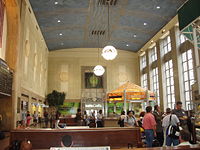
Newark is a hub of air, road, rail, and ship traffic, making it a significant gateway into the New York metropolitan area and the Northeastern United States. Newark Liberty International Airport, the second-busiest airport in the New York region and the fourteenth-busiest in the United States (in terms of passenger traffic), saw nearly 32 million travelers in 2004 and processed nearly 1,000,000 metric tons of freight and mail. Just east of the airport lies Port Newark, the fifteenth-busiest port in the world and the largest container port on the eastern seaboard. In 2003, the port moved over $100 billion in goods.
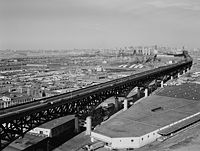
The city is served by numerous highways including the New Jersey Turnpike ( Interstate 95), Interstate 280, Interstate 78, the Garden State Parkway, U.S. Route 1/9, U.S. Route 22, and Route 21. Newark is connected to the Holland Tunnel and Lower Manhattan by the Pulaski Skyway, spanning both the Passaic and Hackensack Rivers.
Local streets in Newark conform to a quasi-grid form, with major streets radiating outward (like spokes on a wheel) from the downtown area. Some major roads in the city are named after the towns to which they lead, including South Orange Avenue, Springfield Avenue, and Bloomfield Avenue. These are some of the oldest roads in the city.
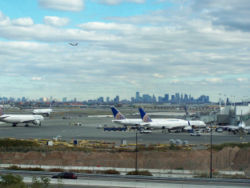
Newark Penn Station, situated just east of downtown, is a major train station for the city and the region, connecting the interurban PATH system (which links Newark to Manhattan) with three New Jersey Transit commuter rail lines and Amtrak service to Philadelphia and Washington, D.C. Only one mile north, the Newark Broad Street Station is served by two commuter rail lines. The two train stations are linked by the Newark Light Rail system, which also provides services from Newark Penn Station to the city's northern communities and into the neighboring towns of Belleville and Bloomfield. Built in the bed of the Morris Canal, the light rail cars runs underground in Newark's downtown area. The city's third train station, Newark Liberty International Airport, connects the Northeast Corridor and North Jersey Coast Line to the airport via AirTrain Newark. Bus service in Newark is provided by New Jersey Transit, CoachUSA contract operators, and DeCamp in North Newark.
The Newark-Elizabeth Rail Link is a proposed light rail project that will link downtown Newark with neighboring Elizabeth and Newark Liberty International Airport. The first section of the light rail link, connecting Newark Penn Station with Broad Street Station one mile (1.6 km) away, began service on July 17, 2006.
Newark is served by New Jersey Transit bus routes 1, 5, 11, 13, 21, 25, 27, 28, 29, 34, 37, 39, 40, 41, 42, 43, 59, 62, 65, 66, 67, 70, 71, 72, 73, 74, 75, 76, 78, 79, 90, 92, 93, 94, 96, 99, 107, and 108. Bus route 308 is an express bus route to Six Flags Great Adventure from Newark Penn Station while 319 is an express service to Atlantic City.
Hospitals and health services
Newark is home to seven hospitals, a remarkable number for a city of its size. University Hospital is the principal teaching hospital of the UMDNJ-New Jersey Medical School and is the busiest Level I trauma centre in the state. Newark Beth Israel Medical Centre is the largest hospital in the city and is a part of the Saint Barnabas Health Care System, the state's largest system of hospital and health care facilities. Beth Israel is also one of the oldest hospitals in the city, dating back to 1901. This 669-bed regional facility is also home to the Children's Hospital of New Jersey. Other hospitals in Newark include the St. James Hospital, St. Michael's Medical Centre, Columbus Hospital, Mount Carmel Guild Hospital, and United Hospitals Medical Centre (now closed).
Points of interest
- First Presbyterian Church Cemetery
- Mount Olivet Cemetery
- Cathedral Basilica of the Sacred Heart
